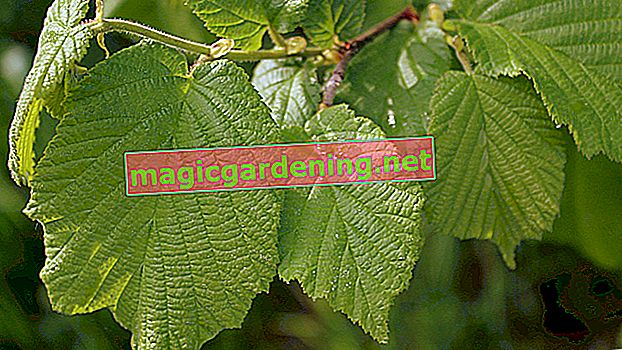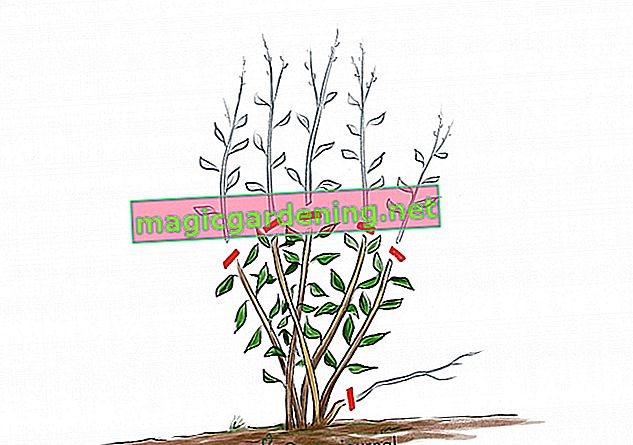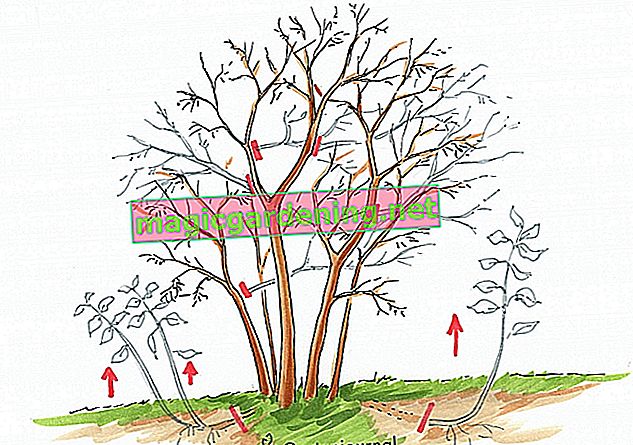
Cut hazelnut as a tree and shrub
The cut depends largely on whether it is a hazelnut bush (Corylus avellana) or a tree hazel(Corylus colurna). Both species and their varieties come from the genus hazel within the birch family. In March and April, the deciduous woody plants bear male catkins and female, reddish flowers, which transform into aromatic, crisp brown hazelnuts by autumn. A hazelnut bush reaches heights of up to 7 meters and becomes just as wide. The growth is characterized by an annual increase of 50 to 90 centimeters. As a tree, the wood reaches imposing dimensions of up to 20 meters in height, with a crown width of 4 to 8 meters. Baum-Hazel takes it much slower with annual growth of 20 to 35 centimeters. The following overview summarizes all types of pruning for shrubs and trees:
also read
- Is the hazelnut a shrub or a tree?
- How big does the hazelnut actually get?
- Are parts of the hazelnut poisonous?
| Cut type | Goal / occasion | best date |
|---|---|---|
| Plant pruning as a shrub | dense branching at the base of the bush | after planting |
| Upbringing as a shrub | well-formed growth | during the first 3 to 4 years |
| Conservation pruning as a shrub | Thinning out dead wood, shortening shoots that are too long | between late autumn and late winter |
| Conservation pruning tree | light-flooded crown, control of crown expansion | after harvest |
| Rejuvenating cut shrub | Revitalize aged hazelnuts | Early October to late February |
| Taper cut tree | rejuvenate bald, sweeping crown | Early October to late February |
For the small garden and tub, the hazel genus brings us with the corkscrew hazel a natural spontaneous mutation with fascinating decorative value. Its branches form a spiral, which is what the name of the species refers to. The deciduous wood reaches heights of 150 to 250 centimeters, so that it can be used as a shrub or tall trunk in the front yard as a friendly reception committee. When it comes to pruning, there are no differences to the common hazelnut bush.
Plant pruning stimulates branching
If a hazelnut as a solitary shrub or a free-growing natural hedge is on the design plan, gardeners do not have to dig deep into their pockets for young plants. Bare-root young plants with a height of 60 to 100 centimeters are available from competent nurseries for 3 to 4 euros. Young shrubs with root balls that are grown in the container are available for less than 10 euros. So that the trees grow vital and healthy, a targeted plant pruning triggers the branching. Act according to the rule of thumb: the smaller the root volume and plant size, the more vigorously the cut is made. How to do it right:
- Cut back the hazelnut bush after planting
- Shorten all shoots by half of the roots
- Cut off damaged root strands
- On high-quality pots, prune weak twigs by a third, only prune strong shoots at the tips
As the illustration below shows, bold pruning may be required, even if it is difficult. Without a consequent pruning of the plant, the hazelnut pumps all reserve substances towards the tip buds in order to grow towards the light at a rapid pace. Buds at the beginning of the plant are almost empty, so that a bare shrub base is preprogrammed on the day of planting. By cutting off the preferred buds on the shoot tips, you counteract the unwanted process.

Raise hazelnut bush
A hazelnut bush fits in harmoniously with the creative garden design if you build up a stable framework over a period of three to four years. The common hazelnut is a decorative showcase with 7 to 10 bottom shoots . As a spectacular freak of nature, the corkscrew willow shines in all its splendor with 5 to 7 ground shoots . By forcing up growth in stages, you encourage dense branching near the ground. How to properly grow a hazelnut bush:
- Time window is open from the beginning of October
- Cut hazelnuts in frost-free weather without blazing sun
- Select the most promising ground shoots for the scaffolding
- Cut off all remaining ground shoots at the base
Extend each scaffold shoot by around 10 centimeters per year until you reach the desired final height. Always cut a short distance from an outward-facing bud or a well-positioned leaf knot to determine the ideal growth direction for the next season. A distance of 3 to 5 millimeters to the bud is well chosen so that the vegetation point is not damaged or does not sprout due to a stub that is too long.
background
Perfect shape thanks to the parenting cut - juice jam makes it possible
Caring for the pruning in the first three to four years has positive effects on the entire life of a hazelnut. So that the shrub branches densely near the ground, the flow of sap must be throttled during the youth phase. You can do this by removing the current tip buds at least once a year in order to divert the sap into the buds lying deeper. Without an upbringing, the growth law of peak funding rules, so that the growth is concentrated on the top buds. Buds positioned further down in the shrub remain dormant, resulting in a bare base.Maintenance cut at 3-year intervals
Once a hazelnut has successfully passed the upbringing phase, pruning is on the agenda at longer intervals. Under normal conditions, a maintenance cut every 2 to 3 years is beneficial for vitality and shape retention. In order to keep the growth in check in the small garden, annual pruning dates are advisable. How to cut expertly:
- The best time is in late autumn, from the beginning of October
- Thoroughly thin out dead wood
- Cut away the twigs growing inside the hazelnut
- Remove three to four of the oldest ground shoots in exchange for young ones
- Scaffold shoots with heavily branched heads lead to a lower side shoot
Continuous rejuvenation by exchanging old for young scaffold shoots keeps your hazelnut vital and blooming. To reliably differentiate young from old wood, assess the degree of branching. Young, annual shoots thrive unbranched. Only in the course of the years more and more side branches are added.

Tips
Sometimes normal, straight wild shoots sprout from the rhizome of a corkscrew willow. Simply tear off the unwanted branches as soon as they catch your eye. Thanks to this care, the bizarre twisted twigs in the bush have the upper hand.
Tree hazel conservation pruning - this is how it works
Tree hazel wears its slim, conical crown when it is young. Over time, the crown flattens noticeably and takes on an expansive width of up to 8 meters, with a height of 12 to 20 meters. This sometimes causes space problems in the private garden, which make regulating pruning inevitable. On this occasion, the crown should be freed from dead wood and unfavorably standing branches. How to properly cut tree hazel:
- Cut the hazel tree if necessary
- The best time is after the harvest and the fall of leaves in autumn
- First cut back all accessible branches that have grown too long
- Thin out dead branches on astring
- Too long, heavily overhanging branches lead to a young side shoot
The wood is easy to cut. Equipped with good quality loppers (optionally as bypass or anvil shears) and telescopic loppers, you can cut back over-long shoots without dizzying climbing into the crown. If aged, dead branches need to be thinned out, master the cut with a folding or hacksaw. For a professional cut, it is important to ensure that you do not damage the bark of a hazel tree. Cut or saw a short distance from the bark or astring, which can be seen as a bulge in the transition from the branch to the trunk.
Digression
Thin out thick branches in stages
The mighty crown of a tree hazel develops its picturesque pyramid shape without a cut. However, when the tree is older, it may be necessary to remove an old, thick branch. Do not saw off the branch in question in one go . There is a great risk that it will tear off and create a large wound on the bark. By using a special cutting technique, you can effectively prevent fatal damage. First set the saw about 40 centimeters awayto the actual interface. Saw the branch from below to the middle. Pull out the saw to move it 4 to 8 inches to the left or right. Now saw from above until the branch breaks off. Cut off the stump on astring. Finally, smooth the cut and coat the wound edges thinly with tree wax (€ 5.99 on Amazon *) to protect the valuable cambium wood from frost.Rejuvenate old hazelnut bush
Without an occasional clearing and conservation pruning, a dense network of shoots develops in the hazelnut bush, which, due to lack of light, becomes bald and bears increasingly fewer flowers and nuts. Instead of clearing a hazelnut old man, get growth, flowering and fruit yield going with a radical rejuvenation cut. This is how it works:
- The best time is between the beginning of October and the end of February
- First cut off all dead ground shoots at the base
- Cut back the remaining scaffold shoots at knee level
If you have put a hazelnut on the stick, you will promote growth with a balanced supply of nutrients. Apply 3 to 4 liters of compost and 100 to 150 grams of horn shavings per square meter of root disc. (€ 6.39 at Amazon *) Rake in the organic fertilizer on the surface so as not to damage the shallow root system. Then pour in plenty. Within two to three years the shrub will regenerate to bloom again and give you a rich nut harvest.
background
Winter rejuvenation cut in consensus with nature and law
In the middle of the summer vegetation period, the consequences of baldness and aging on a hazelnut can no longer be overlooked. But don't be carried away to put an old shrub on the stick straight away. Brooding birds don't care about the decorative value of trees as long as there is room for them to build nests. Ecological jewels such as the hazelnut are very popular as an ideal retreat for the annual hatchery. For this reason, gardeners who are close to nature let the scissors and saws rest in summer so as not to disturb feathered gardeners looking after their offspring. The Federal Nature Conservation Act places particular emphasis on the necessity and has a strict grace period from March 1st to September 30th. Radical cutting measures are exceptionally permitted from October 1st to February 28th, such as thinning out or sitting on the stick.frequently asked Questions
Are corkscrew hazel nuts edible?
With a corkscrew hazel the decoratively twisted branches are the focus. That doesn't mean that the spherical brown fruits will be forgotten. In contrast to the game, the attractive variant has fewer nuts, which can of course be turned into numerous delicacies. As a basic ingredient for sweet hazelnut cream or hearty, aromatic hazelnut-herb coating for meat dishes, corkscrew hazelnuts pamper the palate as well as fresh and crunchy in morning muesli. It is important to note the harvest at the right time for carefree enjoyment. Only pick hazelnuts when they have a deep brown skin.
At what age does the hazelnut bear fruit for the first time? What can be the cause if the shrub does not bloom and bear fruit?
A hazelnut first goes through a youth phase. During this time the shrub does not bloom or produce fruit. After 3 to 4 years in the garden, the large shrub develops its flower dress for the first time and produces crisp hazelnuts in autumn. A pruning in winter is synonymous with a total loss of flowers and fruits, because all the buds are removed. Furthermore, fertilization that is too nitrogen-rich can extend the youth phase by a few years. If you prune your hazelnut according to the instructions in this tutorial and fertilize with compost instead of blue grain, the nuts will not be long in coming.
Can I keep a hazelnut in the bucket on the terrace?
Cultivation in the bucket is quite possible. An adequate supply of water and nutrients is important. In the tightly dimensioned substrate volume in plant containers, the supplies are used up much faster than in the bed. Furthermore, a suitable bucket should be at least 50 liters so that the large shrub feels safe in it.
Do I need two hazelnuts (male and female) for me to harvest fruit?
Hazelnuts (Corylus avellana) thrive as single shrubs. This means that a shrub bears both male, long, yellow catkin flowers and female, small, red flowers and pollinates itself. One copy is therefore sufficient to harvest hazelnuts in autumn. A second hazel bush downwind can increase the yield.
We have thinned out our old hazelnut bush thoroughly and would now like to decoratively plant it under. Which plants are suitable for such a shady location?
Underplanting densely leafed hazelnuts should be tough. As shallow roots, the bushes exert massive root pressure on their immediate surroundings. Light is in short supply under the dense foliage. Nevertheless, some shade-tolerant perennials are not deterred by the harsh living conditions on the root disc of a hazelnut and thrive splendidly. Small periwinkle (Vinca minor) is also part of the illustrious circle, as is cherry laurel as a ground cover (Prunus laurocerasus 'Mount Vernon').
Is it possible to raise the hazelnut as a stem yourself? What to look out for
A young hazelnut with a straight central shoot is perfect for raising a tall trunk. Since the most beautiful hazelnuts thrive on sunny branches, we recommend building a hollow crown. First, guide the central drive on a support rod to the desired height. Then, after two to three years, choose an advantageous branching and cut off the central shoot above it. Build up a framework from four to six side branches that are arranged in a circle. Excess side shoots on the trunk are removed.
We would like to enclose our garden with a 10 meter long and 5 meter high wild fruit hedge. The hazelnut is our favorite. Which wild fruit trees go well with this?
For a varied wild fruit hedge, we recommend combining the hazelnut with local wild fruit trees. Suitable plant partners are Cornelian cherry (Cornus mas), real apple rose (Rosa villosa), rock pear (Amelanchier spicata) and black and red currant (Ribes nigrum and Ribes Jonker van Tets). In addition, the dog rose (Rosa canina) provides picturesque peel blossoms and colorful rose hips. With a planting distance of 120 centimeters, the bushes quickly form a dense hedge with a privacy factor.
The 3 most common mistakes
If a hazel bush does not give the gardener any nuts or transmutes into an impenetrable thicket, the pruning has failed. Although common hazel and tree hazel are rarely pruned, pruning should not be completely ignored and done at the right time. The following table draws attention to the three most common misconceptions about cutting hazelnuts:
| Cutting errors | Damage | prevention |
|---|---|---|
| Shrub or crown never thinned out | bald, matted growth, few hazelnuts | clear every three to four years |
| cut in late winter / spring | Failure of flowering time and fruit yield | always cut between late autumn and late winter |
| old shrub put on the stick in one passage | Total failure | Rejuvenate the hazelnut in three stages |
Tips
A common reason for pruning hazelnuts and corkscrew hazel is to move to a new location. You can transplant the wood within the first five years without any problems, provided you observe two important premises. Transplanting should only be done during the leaf-free period of late autumn and winter. Furthermore, the lost root mass should be compensated for by cutting back hard by half.







